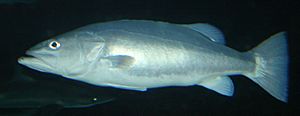Hāpuku facts for kids
Quick facts for kids Hāpuku |
|
|---|---|
 |
|
| Hāpuku from Kelly Tarlton's Sea Life Aquarium, Auckland. | |
| Scientific classification | |
| Synonyms | |
|
The hāpuku (also called hapuka or groper) is a large fish found in the southern parts of the world. Its scientific name is Polyprion oxygeneios. It belongs to a group of fish called wreckfish.
You can find hāpuku around southern Australia, southern South America, South Africa, Tristan da Cunha, and New Zealand. They live deep in the ocean, usually between 30 and 800 meters down. These fish can grow quite big, from 60 to 180 centimeters long. They can also weigh up to 100 kilograms! Sometimes, people call them "cod," but that's not quite right, as cod are different fish.
Contents
Description
Hāpuku fish are usually grey with shiny white bellies. Young hāpuku are often blue. They have 10 strong spines along their back. They also have rounded fins on their belly and chest, and a big, strong, square-shaped tail.
Their lower jaw sticks out further than their top jaw. They have very large eyes, which help them see and hunt in the deep, dark parts of the ocean where there isn't much light.
Habitat and feeding
Young hāpuku are thought to live in the open ocean, swimming freely (this is called being pelagic). When they grow to about 50 centimeters, they start living closer to the seabed (this is called being demersal).
Hāpuku live in cool and warm waters of the southern Indian Ocean and Pacific Ocean. You can find them in places like Chile, southeastern Australia, and New Zealand. They usually prefer waters deeper than 50 meters, but they can be found from 10 to 800 meters deep. In shallower areas, they often hide in cracks, caves, or rocky shelters.
These fish are very good hunters. They eat many different kinds of other fish, as well as invertebrates (animals without backbones) and crustaceans like crabs and crayfish. Some of their favorite meals include red cod, blue cod, and hoki.
Age and growth
Hāpuku are large fish that grow slowly and live for a long time. They become old enough to have babies (reach sexual maturity) when they are between 10 and 13 years old. They can live for up to 60 years!
While they can grow as big as 100 kilograms, most hāpuku found are around 25 kilograms. Their average length is 80 to 100 centimeters, but they can grow up to 180 centimeters long.
Human consumption
Hāpuku is a very popular fish to eat. It is highly valued in both local and international markets. Chefs who have tried hāpuku raised on farms say it tastes even better than hāpuku caught in the wild.
In New Zealand, in 2008, hāpuku caught for sale were worth about NZ$37 million. A smaller amount, about $4.29 million, was sold to other countries. Hāpuku is caught by both commercial fishing boats and people fishing for fun in New Zealand. It's a very desired fish, but not many are caught. Because of this, the number of hāpuku caught is carefully managed by New Zealand's Quota Management System. Currently, there's no size limit for hāpuku in New Zealand, but you can only catch five fish per person per day.
Aquaculture
Many people around the world are interested in farming hāpuku. This is called aquaculture. In Europe, a very similar type of wreckfish is considered a special food. Because of this, many types of Polyprion fish have been caught too much in some areas.
In New Zealand, a group called the National Institute of Water and Atmospheric Research (NIWA) sees hāpuku as a great chance for New Zealand to grow its fish farming industry. They have found markets for hāpuku in New Zealand, Australia, Europe, and Asia.
Research and development
Since 2003, NIWA has gathered the largest collection of hāpuku parent fish (called broodstock) in the world. These parent fish are kept in large tanks at the Bream Bay Aquaculture Park. Each tank has its own special environment. This environment controls the temperature and light to help the fish lay eggs naturally (this is called spawning).
NIWA has made great progress in all parts of raising hāpuku in a hatchery. They faced challenges similar to those found when farming other fish like halibut and sea bass. But they found special ways to solve these problems for young hāpuku.
The main challenges they overcame were:
- Designing a system to successfully hatch the eggs and care for the tiny baby fish (called larvae).
- Getting the baby fish to start eating for the first time.
- Helping the young fish switch from eating live food to special fish food. This prepares them to be moved to sea cages.
Right now, NIWA is testing how well hāpuku grow in sea cages and tanks. These early tests show that hāpuku have a lot of potential to grow well in fish farms.
Since 2007, NIWA has been running a program to choose the best parent fish. They are learning which parent fish produce the strongest first generation of hāpuku. With this information, they will soon be able to choose fish with the best qualities for their breeding program. NIWA wants to keep New Zealand at the forefront of hāpuku farming. Their goal is for hāpuku to become a very important fish for New Zealand's aquaculture industry.
Images for kids
See also
 In Spanish: Hāpuku para niños
In Spanish: Hāpuku para niños


